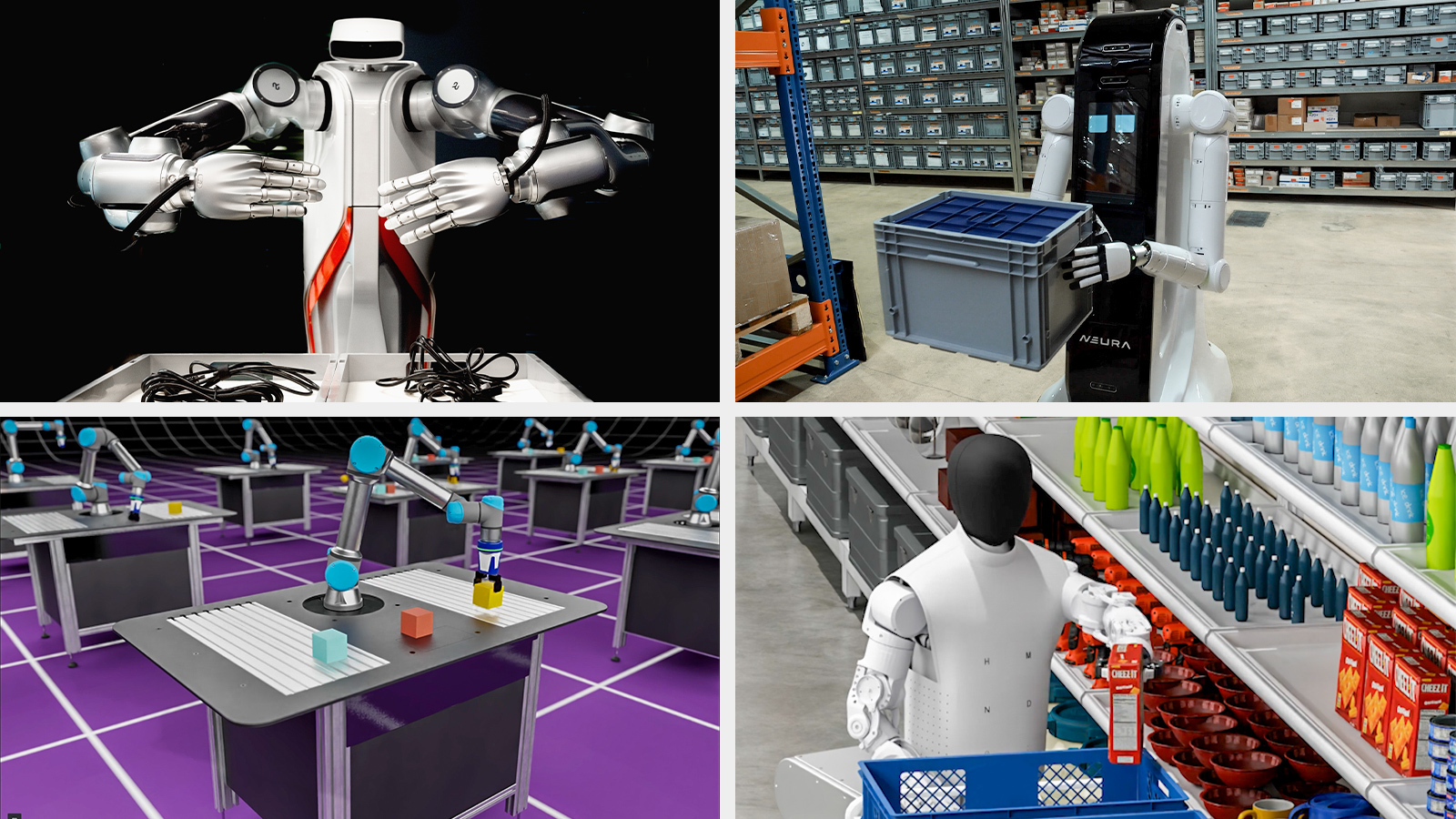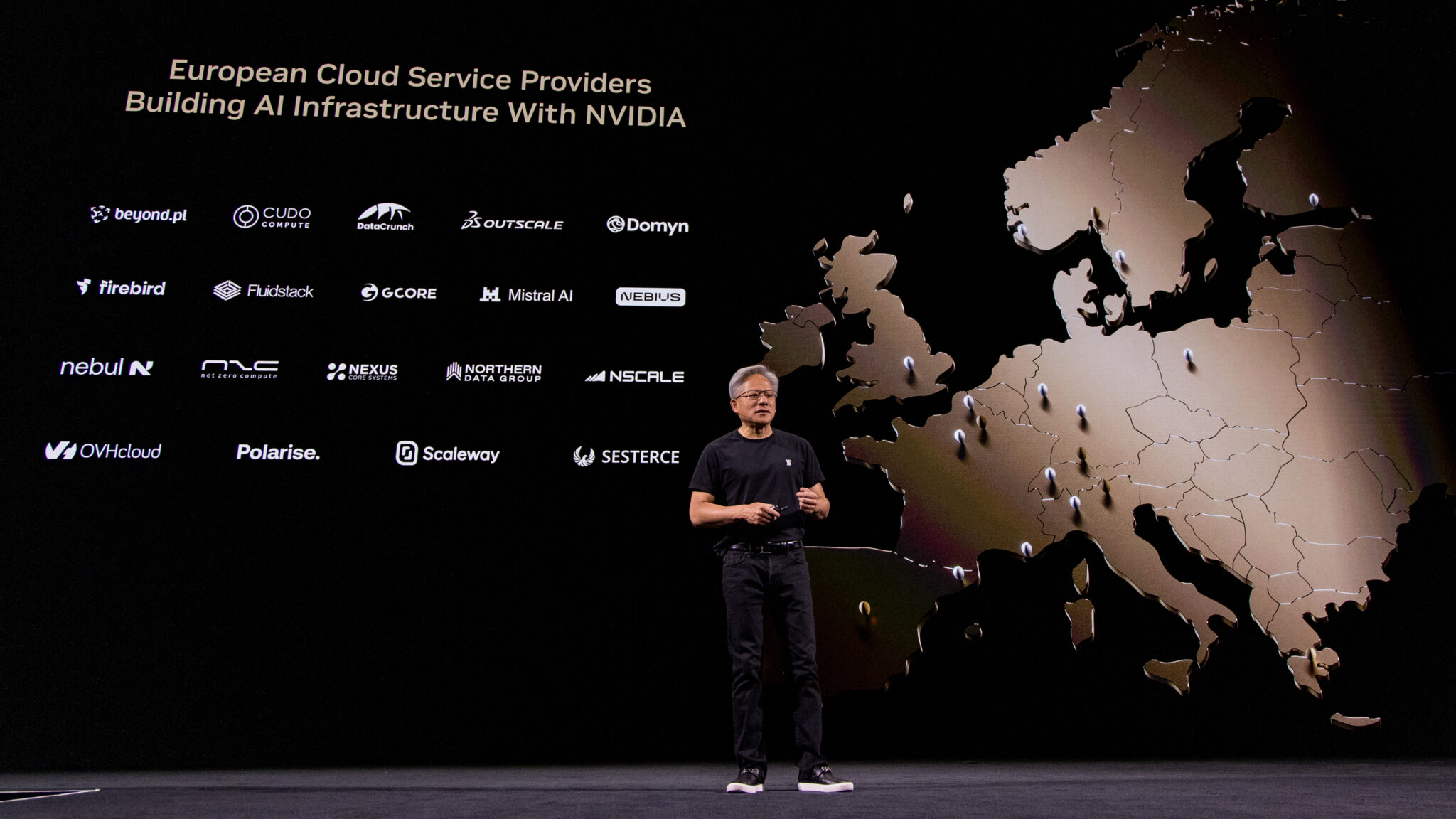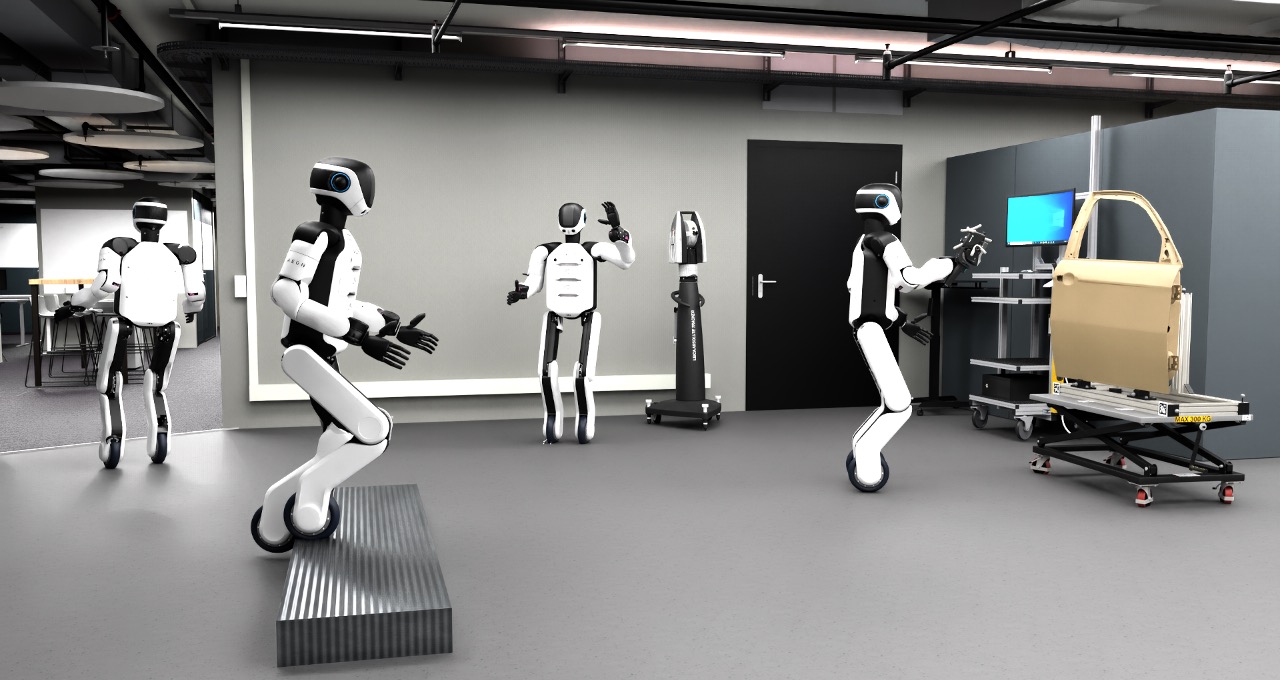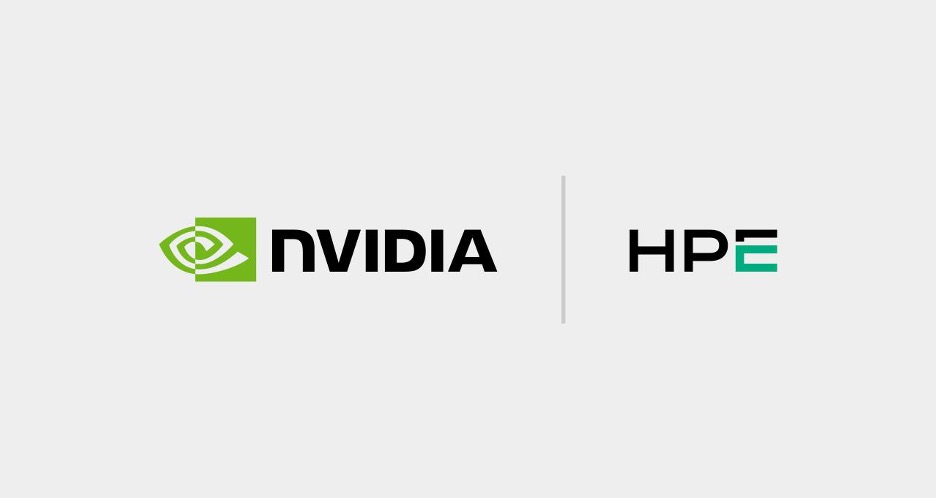European Robot Makers Adopt NVIDIA Isaac, Omniverse and Halos to Develop Safe, Physical AI-Driven Robot Fleets
In the face of growing labor shortages and need for sustainability, European manufacturers are racing to reinvent their processes to become software-defined and AI-driven.
To achieve this, robot developers and industrial digitalization solution providers are working with NVIDIA to build safe, AI-driven robots and industrial technologies to drive modern, sustainable manufacturing.
At NVIDIA GTC Paris at VivaTech, Europe’s leading robotics companies including Agile Robots, Extend Robotics, Humanoid, idealworks, Neura Robotics, SICK, Universal Robots, Vorwerk and Wandelbots are showcasing their latest AI-driven robots and automation breakthroughs, all accelerated by NVIDIA technologies. In addition, NVIDIA is releasing new models and tools to support the entire robotics ecosystem.
NVIDIA Releases Tools for Accelerating Robot Development and Safety
NVIDIA Isaac GR00T N1.5, an open foundation model for humanoid robot reasoning and skills, is now available for download on Hugging Face. This update enhances the model’s adaptability and ability to follow instructions, significantly improving its performance in material handling and manufacturing tasks. The NVIDIA Isaac Sim 5.0 and Isaac Lab 2.2 open-source robotics simulation and learning frameworks, optimized for NVIDIA RTX PRO 6000 workstations, are available on GitHub for developer preview.
In addition, NVIDIA announced that NVIDIA Halos — a full-stack, comprehensive safety system that unifies hardware architecture, AI models, software, tools and services — now expands to robotics, promoting safety across the entire development lifecycle of AI-driven robots.
The NVIDIA Halos AI Systems Inspection Lab has earned accreditation from the ANSI National Accreditation Boardto perform inspections across functional safety for robotics, in addition to automotive vehicles.
“NVIDIA’s latest evaluation with ANAB verifies the demonstration of competence and compliance with internationally recognized standards, helping ensure that developers of autonomous machines — from automotive to robotics — can meet the highest benchmarks for functional safety,” said R. Douglas Leonard Jr., executive director of ANAB.
Arcbest, Advantech, Bluewhite, Boston Dynamics, FORT, Inxpect, KION, NexCobot — a NEXCOM company, and Synapticon are among the first robotics companies to join the Halos Inspection Lab, ensuring their products meet NVIDIA safety and cybersecurity requirements.
To support robotics leaders in strengthening safety across the entire development lifecycle of AI-driven robots, Halos will now provide:
Safety extension packages for the NVIDIA IGX platform, enabling manufacturers to easily program safety functions into their robots, supported by TÜV Rheinland’s inspection of NVIDIA IGX.
A robotic safety platform, which includes IGX and NVIDIA Holoscan Sensor Bridge for a unified approach to designing sensor-to-compute architecture with built-in AI safety.
An outside-in safety AI inspector — an AI-powered agent for monitoring robot operations, helping improve worker safety.
Europe’s Robotics Ecosystem Builds on NVIDIA’s Three Computers
Europe’s leading robotics developers and solution providers are integrating the NVIDIA Isaac robotics platform to train, simulate and deploy robots across different embodiments.
Agile Robots is post-training the GR00T N1 model in Isaac Lab to train its dual-arm manipulator robots, which run on NVIDIA Jetson hardware, to execute a variety of tasks in industrial environments.
Meanwhile, idealworks has adopted the Mega NVIDIA Omniverse Blueprint for robotic fleet simulation to extend the blueprint’s capabilities to humanoids. Building on the VDA 5050 framework, idealworks contributes to the development of guidance that supports tasks uniquely enabled by humanoid robots, such as picking, moving and placing objects.
Neura Robotics is integrating NVIDIA Isaac to further enhance its robot development workflows. The company is using GR00T-Mimic to post-train the Isaac GR00T N1 robot foundation model for its service robot MiPA. Neura is also collaborating with SAP and NVIDIA to integrate SAP’s Joule agents with its robots, using the Mega NVIDIA Omniverse Blueprint to simulate and refine robot behavior in complex, realistic operational scenarios before deployment.
Vorwerk is using NVIDIA technologies to power its AI-driven collaborative robots. The company is post-training GR00T N1 models in Isaac Lab with its custom synthetic data pipeline, which is built on Isaac GR00T-Mimic and powered by the NVIDIA Omniverse platform. The enhanced models are then deployed on NVIDIA Jetson AGX, Jetson Orin or Jetson Thor modules for advanced, real-time home robotics.
Humanoid is using NVIDIA’s full robotics stack, including Isaac Sim and Isaac Lab, to cut its prototyping time down by six weeks. The company is training its vision language action models on NVIDIA DGX B200 systems to boost the cognitive abilities of its robots, allowing them to operate autonomously in complex environments using Jetson Thor onboard computing.
Universal Robots is introducing UR15, its fastest collaborative robot yet, to the European market. Using UR’s AI Accelerator — developed on NVIDIA Isaac’s CUDA-accelerated libraries and AI models, as well as NVIDIA Jetson AGX Orin — manufacturers can build AI applications to embed intelligence into the company’s new cobots.
Wandelbots is showcasing its NOVA Operating System, now integrated with Omniverse, to simulate, validate and optimize robotic behaviors virtually before deploying them to physical robots. Wandelbots also announced a collaboration with EY and EDAG to offer manufacturers a scalable automation platform on Omniverse that speeds up the transition from proof of concept to full-scale deployment.
Extend Robotics is using the Isaac GR00T platform to enable customers to control and train robots for industrial tasks like visual inspection and handling radioactive materials. The company’s Advanced Mechanics Assistance System lets users collect demonstration data and generate diverse synthetic datasets with NVIDIA GR00T-Mimic and GR00T-Gen to train the GR00T N1 foundation model.
SICK is enhancing its autonomous perception solutions by integrating new certified sensor models — as well as 2D and 3D lidars, safety scanners and cameras — into NVIDIA Isaac Sim. This enables engineers to virtually design, test and validate machines using SICK’s sensing models within Omniverse, supporting processes spanning product development to large-scale robotic fleet management.
Toyota Material Handling Europe is working with SoftServe to simulate its autonomous mobile robots working alongside human workers, using the Mega NVIDIA Omniverse Blueprint. Toyota Material Handling Europe is testing and simulating a multitude of traffic scenarios — allowing the company to refine its AI algorithms before real-world deployment.
NVIDIA’s partner ecosystem is enabling European industries to tap into intelligent, AI-powered robotics. By harnessing advanced simulation, digital twins and generative AI, manufacturers are rapidly developing and deploying safe, adaptable robot fleets that address labor shortages, boost sustainability and drive operational efficiency.
Watch the NVIDIA GTC Paris keynote from NVIDIA founder and CEO Jensen Huang at VivaTech, and explore GTC Paris sessions.
See notice regarding software product information.
#european #robot #makers #adopt #nvidia
European Robot Makers Adopt NVIDIA Isaac, Omniverse and Halos to Develop Safe, Physical AI-Driven Robot Fleets
In the face of growing labor shortages and need for sustainability, European manufacturers are racing to reinvent their processes to become software-defined and AI-driven.
To achieve this, robot developers and industrial digitalization solution providers are working with NVIDIA to build safe, AI-driven robots and industrial technologies to drive modern, sustainable manufacturing.
At NVIDIA GTC Paris at VivaTech, Europe’s leading robotics companies including Agile Robots, Extend Robotics, Humanoid, idealworks, Neura Robotics, SICK, Universal Robots, Vorwerk and Wandelbots are showcasing their latest AI-driven robots and automation breakthroughs, all accelerated by NVIDIA technologies. In addition, NVIDIA is releasing new models and tools to support the entire robotics ecosystem.
NVIDIA Releases Tools for Accelerating Robot Development and Safety
NVIDIA Isaac GR00T N1.5, an open foundation model for humanoid robot reasoning and skills, is now available for download on Hugging Face. This update enhances the model’s adaptability and ability to follow instructions, significantly improving its performance in material handling and manufacturing tasks. The NVIDIA Isaac Sim 5.0 and Isaac Lab 2.2 open-source robotics simulation and learning frameworks, optimized for NVIDIA RTX PRO 6000 workstations, are available on GitHub for developer preview.
In addition, NVIDIA announced that NVIDIA Halos — a full-stack, comprehensive safety system that unifies hardware architecture, AI models, software, tools and services — now expands to robotics, promoting safety across the entire development lifecycle of AI-driven robots.
The NVIDIA Halos AI Systems Inspection Lab has earned accreditation from the ANSI National Accreditation Boardto perform inspections across functional safety for robotics, in addition to automotive vehicles.
“NVIDIA’s latest evaluation with ANAB verifies the demonstration of competence and compliance with internationally recognized standards, helping ensure that developers of autonomous machines — from automotive to robotics — can meet the highest benchmarks for functional safety,” said R. Douglas Leonard Jr., executive director of ANAB.
Arcbest, Advantech, Bluewhite, Boston Dynamics, FORT, Inxpect, KION, NexCobot — a NEXCOM company, and Synapticon are among the first robotics companies to join the Halos Inspection Lab, ensuring their products meet NVIDIA safety and cybersecurity requirements.
To support robotics leaders in strengthening safety across the entire development lifecycle of AI-driven robots, Halos will now provide:
Safety extension packages for the NVIDIA IGX platform, enabling manufacturers to easily program safety functions into their robots, supported by TÜV Rheinland’s inspection of NVIDIA IGX.
A robotic safety platform, which includes IGX and NVIDIA Holoscan Sensor Bridge for a unified approach to designing sensor-to-compute architecture with built-in AI safety.
An outside-in safety AI inspector — an AI-powered agent for monitoring robot operations, helping improve worker safety.
Europe’s Robotics Ecosystem Builds on NVIDIA’s Three Computers
Europe’s leading robotics developers and solution providers are integrating the NVIDIA Isaac robotics platform to train, simulate and deploy robots across different embodiments.
Agile Robots is post-training the GR00T N1 model in Isaac Lab to train its dual-arm manipulator robots, which run on NVIDIA Jetson hardware, to execute a variety of tasks in industrial environments.
Meanwhile, idealworks has adopted the Mega NVIDIA Omniverse Blueprint for robotic fleet simulation to extend the blueprint’s capabilities to humanoids. Building on the VDA 5050 framework, idealworks contributes to the development of guidance that supports tasks uniquely enabled by humanoid robots, such as picking, moving and placing objects.
Neura Robotics is integrating NVIDIA Isaac to further enhance its robot development workflows. The company is using GR00T-Mimic to post-train the Isaac GR00T N1 robot foundation model for its service robot MiPA. Neura is also collaborating with SAP and NVIDIA to integrate SAP’s Joule agents with its robots, using the Mega NVIDIA Omniverse Blueprint to simulate and refine robot behavior in complex, realistic operational scenarios before deployment.
Vorwerk is using NVIDIA technologies to power its AI-driven collaborative robots. The company is post-training GR00T N1 models in Isaac Lab with its custom synthetic data pipeline, which is built on Isaac GR00T-Mimic and powered by the NVIDIA Omniverse platform. The enhanced models are then deployed on NVIDIA Jetson AGX, Jetson Orin or Jetson Thor modules for advanced, real-time home robotics.
Humanoid is using NVIDIA’s full robotics stack, including Isaac Sim and Isaac Lab, to cut its prototyping time down by six weeks. The company is training its vision language action models on NVIDIA DGX B200 systems to boost the cognitive abilities of its robots, allowing them to operate autonomously in complex environments using Jetson Thor onboard computing.
Universal Robots is introducing UR15, its fastest collaborative robot yet, to the European market. Using UR’s AI Accelerator — developed on NVIDIA Isaac’s CUDA-accelerated libraries and AI models, as well as NVIDIA Jetson AGX Orin — manufacturers can build AI applications to embed intelligence into the company’s new cobots.
Wandelbots is showcasing its NOVA Operating System, now integrated with Omniverse, to simulate, validate and optimize robotic behaviors virtually before deploying them to physical robots. Wandelbots also announced a collaboration with EY and EDAG to offer manufacturers a scalable automation platform on Omniverse that speeds up the transition from proof of concept to full-scale deployment.
Extend Robotics is using the Isaac GR00T platform to enable customers to control and train robots for industrial tasks like visual inspection and handling radioactive materials. The company’s Advanced Mechanics Assistance System lets users collect demonstration data and generate diverse synthetic datasets with NVIDIA GR00T-Mimic and GR00T-Gen to train the GR00T N1 foundation model.
SICK is enhancing its autonomous perception solutions by integrating new certified sensor models — as well as 2D and 3D lidars, safety scanners and cameras — into NVIDIA Isaac Sim. This enables engineers to virtually design, test and validate machines using SICK’s sensing models within Omniverse, supporting processes spanning product development to large-scale robotic fleet management.
Toyota Material Handling Europe is working with SoftServe to simulate its autonomous mobile robots working alongside human workers, using the Mega NVIDIA Omniverse Blueprint. Toyota Material Handling Europe is testing and simulating a multitude of traffic scenarios — allowing the company to refine its AI algorithms before real-world deployment.
NVIDIA’s partner ecosystem is enabling European industries to tap into intelligent, AI-powered robotics. By harnessing advanced simulation, digital twins and generative AI, manufacturers are rapidly developing and deploying safe, adaptable robot fleets that address labor shortages, boost sustainability and drive operational efficiency.
Watch the NVIDIA GTC Paris keynote from NVIDIA founder and CEO Jensen Huang at VivaTech, and explore GTC Paris sessions.
See notice regarding software product information.
#european #robot #makers #adopt #nvidia















_seo_performance_at_an_enterprise_level.svg)
